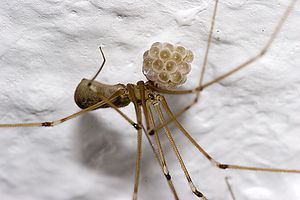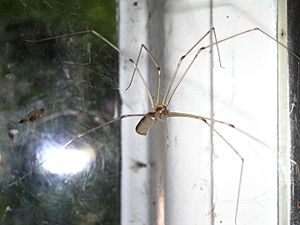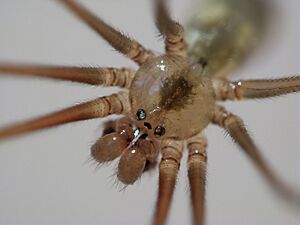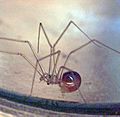Daddy long-legs spider facts for kids
Quick facts for kids Pholcus phalangioides |
|
|---|---|
 |
|
| Female with egg sac | |
| Scientific classification | |
| Kingdom: | |
| Phylum: | |
| Class: | |
| Order: | |
| Family: |
Pholcidae
|
| Genus: |
Pholcus
|
| Species: |
P. phalangioides
|
| Binomial name | |
| Pholcus phalangioides |
|
The Daddy-Long-Legs Spider (Pholcus phalangioides) is a type of spider from the family Pholcidae. Its legs are super long, about 5 or 6 times longer than its body! People sometimes confuse it with other creatures also called "daddy long-legs," but those are not real spiders.
When this spider feels bothered, it shakes its web really fast. This might be to make it harder for predators to see it clearly. You often find these spiders on ceilings in rooms, caves, or cellars, which is why they are also called cellar spiders. They are good at catching and eating other insects like mosquitoes and even other spiders. If there isn't much food, they might even eat their own kind. These spiders originally came from warmer places, so they don't seem to notice the seasons and can have babies any time of the year.
A female spider holds about 20 to 30 eggs in her mouth. Baby spiders are clear and have short legs. They shed their skin about 5 or 6 times as they grow bigger. Female spiders are about 9mm long, and males are a little smaller. Other spiders like Crossopriza lyoni and Physocyclus globosis look very similar to the Daddy-Long-Legs Spider.
Contents
Appearance
Pholcids are delicate spiders. Their bodies are usually 2–10 mm long, but their legs can be up to 50 mm long! Pholcus spiders have bodies that look a bit like a peanut. Their main body part is thin and can be clear, light brown, brown, or gray. They have two groups of three eyes on the sides of their head, plus two smaller eyes in the middle. Some spiders in this family have eight eyes, while others have six.
Habitat
Pholcids live on every continent except Antarctica, because it's too cold there. They hang upside down in messy, tangled webs. These webs are usually built in dark and damp places. You can find them in caves, under rocks, under loose tree bark, in old animal burrows, and in quiet parts of buildings like cellars. That's where they get their common name, "cellar spider." But you can also find Pholcids in warm, dry spots, like house windows and attics.
Behavior
Trapping Prey
Their webs aren't sticky, but their messy shape makes it hard for insects to escape once they get caught. The spider quickly wraps its prey in silk. Then, it bites the prey to kill it. The spider might eat its meal right away or save it for later.
What They Eat
Some of these spiders are quite clever. They will go into the webs of other spiders and eat the spider itself, its eggs, or its trapped prey. Sometimes, they even shake another spider's web. This makes it seem like prey is caught, luring the other spider closer. Pholcids are known to hunt and eat other spiders, including redback spiders, huntsman spiders, and common house spiders. This helps control the numbers of other spider types, which can be helpful for people.
How They Walk
Pholcus phalangioides often walks by moving legs on opposite sides of its body, one after another. This is a common way many spiders walk. However, they can also change their walking pattern often.
Trivia
- This is the only spider species that was described by the Swiss painter and bug expert Johann Kaspar Füssli.
- Some spiders, including P. phalangioides, can completely suck out a mosquito from the tip of one of its legs. This can take a very long time, sometimes up to twelve hours!
Images for kids
-
A marbled cellar spider (Holocnemus pluchei) carrying prey.
-
Male shortbodied cellar spider (Spermophora senoculata) from the United States
See also
 In Spanish: Fólcidos para niños
In Spanish: Fólcidos para niños









